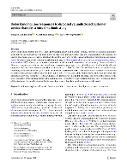| dc.contributor.author | van der Goot, Margot | |
| dc.contributor.author | Koubayová, Nathalie | |
| dc.contributor.author | van Reijmersdal, Eva A. | |
| dc.date.accessioned | 2024-12-12T15:40:47Z | |
| dc.date.available | 2024-12-12T15:40:47Z | |
| dc.date.issued | 2024 | |
| dc.identifier.uri | https://hdl.handle.net/20.500.14178/2758 | |
| dc.description.abstract | Due to huge advancements in natural language processing (NLP) and machine learning, chatbots are gaining significance in the field of customer service. For users, it may be hard to distinguish whether they are communicating with a human or a chatbot. This brings ethical issues, as users have the right to know who or what they are interacting with (European Commission, 2022). One of the solutions is to include a disclosure at the start of the interaction (e.g., "this is a chatbot"). However, companies are reluctant to use disclosures, as consumers may perceive artificial agents as less knowledgeable and empathetic than their human counterparts (Luo et al., 2019). The current mixed methods study, combining qualitative interviews (n = 8) and a quantitative experiment (n = 194), delves into users' responses to a disclosed vs. undisclosed customer service chatbot, focusing on source orientation, anthropomorphism, and social presence. The qualitative interviews reveal that it is the willingness to help the customer and the friendly tone of voice that matters to the users, regardless of the artificial status of the customer care representative. The experiment did not show significant effects of the disclosure (vs. non-disclosure). Implications for research, legislators and businesses are discussed. | en |
| dc.language.iso | en | |
| dc.relation.url | https://doi.org/10.1007/s00146-023-01818-7 | |
| dc.rights | Creative Commons Uveďte původ 4.0 International | cs |
| dc.rights | Creative Commons Attribution 4.0 International | en |
| dc.title | Understanding users' responses to disclosed vs. undisclosed customer service chatbots: a mixed methods study | en |
| dcterms.accessRights | embargoedAccess | |
| dcterms.license | https://creativecommons.org/licenses/by/4.0/legalcode | |
| dc.date.updated | 2024-12-12T16:10:45Z | |
| dc.subject.keyword | Anthropomorphism | en |
| dc.subject.keyword | Chatbots | en |
| dc.subject.keyword | Disclosure | en |
| dc.subject.keyword | Online customer care | en |
| dc.subject.keyword | Social presenceł | en |
| dc.subject.keyword | Source orientation | en |
| dc.identifier.eissn | 1435-5655 | |
| dc.rights.startDate | 2024-01-05 | |
| dc.relation.fundingReference | info:eu-repo/grantAgreement/UK/COOP/COOP | |
| dc.date.embargoStartDate | 2024-12-12 | |
| dc.date.embargoEndDate | 2024-11-01 | |
| dc.type.obd | 73 | |
| dc.type.version | info:eu-repo/semantics/publishedVersion | |
| dc.identifier.doi | 10.1007/s00146-023-01818-7 | |
| dc.identifier.utWos | 001136777300002 | |
| dc.identifier.eidScopus | 2-s2.0-85181486233 | |
| dc.identifier.obd | 640760 | |
| dc.subject.rivPrimary | 50000::50800::50802 | |
| dc.relation.datasetUrl | https://drive.google.com/drive/folders/1AhP9eKmN3q48OhdHfy_gHVqttGBdj8FJ?usp=sharing | |
| dcterms.isPartOf.name | AI & Society | |
| dcterms.isPartOf.issn | 0951-5666 | |
| dcterms.isPartOf.journalYear | 2024 | |
| dcterms.isPartOf.journalVolume | 39 | |
| dcterms.isPartOf.journalIssue | 6 | |
| uk.faculty.primaryId | 118 | |
| uk.faculty.primaryName | Fakulta sociálních věd | cs |
| uk.faculty.primaryName | Faculty of Social Sciences | en |
| uk.department.primaryId | 330 | |
| uk.department.primaryName | Katedra mediálních studií | cs |
| uk.department.primaryName | Department of Media Studies | en |
| dc.description.pageRange | 2947-2960 | |
| dc.type.obdHierarchyCs | ČLÁNEK V ČASOPISU::článek v časopisu::původní článek | cs |
| dc.type.obdHierarchyEn | JOURNAL ARTICLE::journal article::original article | en |
| dc.type.obdHierarchyCode | 73::152::206 | en |
| uk.displayTitle | Understanding users’ responses to disclosed vs. undisclosed customer service chatbots: a mixed methods study | en |

